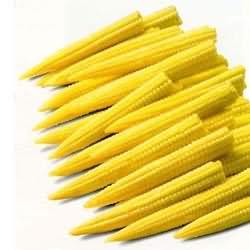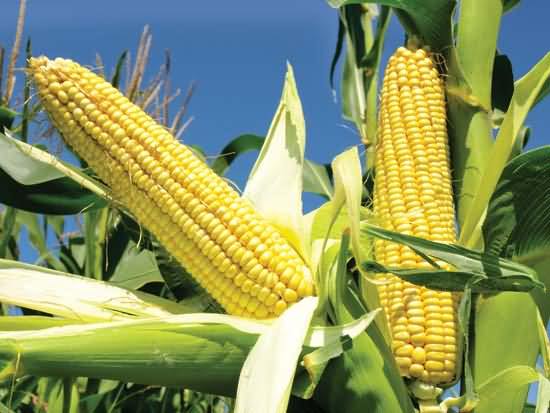किसानों की आय बढ़ाने के लिए विशिष्ट मक्का और उनकी विशेष उत्पादन प्रौद्योगिकियों की भूमिका
Corn or Maize (Zea mays L.) is high-yielding, fast-growing, highly adaptable and multi -utility cereal crop. Maize and wheat are the major source of carbohydrates and proteins for almost a half of the world's human population.
Maize is primarily grown as an energy crop, but the use of different specific types such as sweet maize, popping maize and white seeded maize is quite extensive. It is with respective quality parameters relating to tender ear characteristics, biochemical components relating to protein, sweetness, starch, oil and popping traits are considered as specialty corn.
Compared to field corns, specialty corns possess additional and characteristic features. Their global spread, increasing demand and premium price make them an attractive option for the farmers in many countries including India.
Specialty corns are amenable to numerous options pertaining to harvest time and various economical products. A great diversity of maize grain properties provides the alteration of the grain composition in relation to quantity and quality of certain components.
Due to certain traits and the modes of genetic control of these traits, the mentioned specific types of maize require a special attention in the process of breeding, seed production, commercial production and processing.
Benefits Accrued by Speciality Corn
- Increase in Income
- Increased Crop Intensity
- Added fodder production
- Promote livestock industry – increases milk & meat production
- Check the migration
- Value addition
- Employment generation
- Better Nutrition
Different types of speciality corn
Baby corn is the ear of maize plant harvested young, especially before or just after the silk emergence. The dehusked ears are crisp, sweet, succulent, delicious and can be eaten as salad vegetable.
Baby corn nutritional value is comparable to other vegetables. After harvest the plant by-products, such as tassel, young husk, silk and green stalk provide good cattle feed. It generates employment among the rural poor of all ages.
Baby corn is a good option for crop diversification. It suits best to peri-urban agriculture. It offers great potential to earn foreign exchange through export of fresh/canned baby corn and its processed products.
Currently early maturing maize cultivars originally developed for grain usage are also grown for baby corn purpose with assessment of specific baby corn traits. These cultivars can be used by growers for crop yield and duration advantage.
Desired traits of babycorn
- Medium height and lodging resistance
- Early maturing
- Stay green
- Harvesting within 24 hr of silk appearance when silk is 3-4 cm
- Prolific (> 1 cob/plant)
- Standing leaves
- Length of cob should be <11 cm, radius 1-1.5 cm
- 3-4 picking
Production Technology of babycorn-
The cultivation practices of baby corn is similar to grain crop except,
- Plant population - With seed rate of 22- 25 kg/ha, and plant spacing of 60 X 15-20 cm (plant X row), its plant population is 80,000- 100000.
- Higher dose of nitrogen application - With the increase in plant population, the nutrients requirement also increases. Nitrogen is applied @ 150-200 kg/ha in three equal splits as basal dose at the time of sowing, at knee high stage (20-25 DAS) and at pre-tasseling stage (40-45 DAS).
- Choice of cultivars - Early maturing and prolific cultivars are preferred for baby corn cultivation. HM-4 is the first baby corn hybrid bred in India. Hybrids are preferred over open pollinated varieties because hybrids are more uniform in flowering. Thus they may require only 4-5 time plucking. Contrary to this non uniform flowering of varieties leads to prolonged harvesting. Short stature materials can be well accommodated in higher plants densities.
- Detasseling – It is an essential operation in cultivation of baby corn. It is a removing of tassel as soon as it emerges from flag leaf. This is done to avoid contamination of unfertilized cob with pollens. Leaf/leaves should not be removed with tassel as it reduces 5-15% yield .Removed tassel is nutrient rich and should be fed to cattle.
- Harvesting should be done after 1-3 days of silk emergence from the leaf sheath. Picking when silk comes out 2-3 cm from the top of ears, in morning or evening when moisture is highest and temperature is low. Kharif- picking should be done daily and in rabi on alternate days. In single cross hybrid, 3-4 picking may be obtained.
- Post Harvest Management - Peel baby corn on same day in shady places with good ventilation and air circulation. Corn should not be heaped. Dehusked corn put in plastic containers or sacks and bags .Stored in cool and dry place. Transported to processing unit at earliest.
- Intercropping- In rabi, as many as 20 crops, namely potato , green pea, rajmash for green pods, palak , cabbage ,cauliflower ,sugar beet , green onion, garlic, methi, coriander, knol-khol, broccoli, lettuce, turnip, radish, carrot ,french bean, celery, gladiolus are grown with maize as intercrop. In kharif, cowpea for green pods and fodder purposes, urd, mung are grown.
2. Sweet Corn
Sweet corn is a special maize variety in which it’s tender, delicious seeds eaten as a vegetable. In contrast to traditional field corn, sugar corn varieties are harvested when their corn-ears just reached milk stage.
Standard sweet corn at the immature, milky stage contains about 10 percent sucrose, while field corn in the same stage has about 4 percent sucrose. Its seeds or cobs either used immediately or frozen since sugar content in them quickly converted into starch.
To compete and find a nearby niche (like restaurant or roadside stand) for sweet corn, entrepreneurs should explore the potentials of moving these corns to consumers within a day of harvest.
These kernels at room temperature can lose as much as 50 percent of their sucrose by 24 hours after harvest.
Production Technology
|
Cultural Practices |
Recommendations |
|
Soil |
It can be grown in variety of soils ranging from loamy sand to clay loam. The field should have proper drainage, as maize is sensitive to excess soil moisture. |
|
Time of sowing |
Kharif- June- July Rabi – 25 October to 15 November South India- throughout year |
|
Seed rate and Plant Geometry |
8-10 kg/ha ; 75- 100 x 15- 30 cm |
|
Varieties |
Kharif and Rabi - HSC-1, Madhuri, Priya, Almora sweet corn, win sweet corn |
|
Nutrient Application |
150-180 kg N, 70-80 kg P2O5, 70- 80 kg K2O to be applied in five split doses |
|
Irrigation |
Light Soils – 7-8, heavy soil – 4-5 Critical stages – Flowering and grain filling In winters moisture must be maintained from 15th Dec to 15th Feb |
|
Harvesting |
About 45 days after emergence, the tassel emerges and 2-3 days later the silks emerge. Corn will be ready for harvest approximately 18-22 days after completion of pollination (indicated by drying of silk). Corn is ready for harvest when the ear is full size for the variety, has a tight husk, and has somewhat dried silks. Whether harvested by hand or machine, sweet corn should be collected at night or early in the morning, when the environment remains cool. Every effort should be made to keep harvested ears cool and in shaded areas. |
|
Post-harvest Handling |
Sweet corn has a high respiration rate, the longer the delay, the greater the heating and conversion of sugar to starch with subsequent quality loss. Sweet corn must be moved quickly from the field to packing sheds, where it should be rapidly sorted, packed, and cooled. |
|
Precautions |
Isolation of "sweet corn" cultivar is necessary to prevent cross-pollination. Isolation can be obtained by planting at a different time, planting cultivars of different maturities, or providing barriers and border rows. |
3. Popcorn
 Popcorn is a popular snack food throughout the world.
Popcorn is a popular snack food throughout the world.
Kernels of popcorn range in colour from off-white to light gold, to red, black and many colours in between. When kernels of popcorn are heated, they explode and produce large puffed flakes (popping).
Although conditions for growing popcorn are the same as for dent corn, special harvesting, drying and storage practices are necessary to maintain popping quality
| Practices | Recommendations |
| Field condition | Good drainage |
| Soil | Medium to coarse textured soils |
| Sowing time | South 1st June – 15th June |
| North 25th June – 20th July | |
| Seed Rate | 12-14 kg/ha |
| Spacing | 75-90 cm X 20- 25 cm,50,000 to 67,000 plants per ha |
| Varieties | Kharif & Rabi - Amber popcorn, VL Almora popcorn & pearl Popcorn |
| Fertilizer | NPK : 80:60:40 per hectareN to be applied in 3 doses (33% at sowing, 33% after 25 days and 33% after 45 days) |
| Irrigation | Light Soils – 7-8, heavy soil – 4-5Critical stages – Flowering and grain filling In winters moisture must be maintained from 15th Dec to 15th Feb |
| Crop management | Seed treatment: Thiram @ 4 gm/kg and fipronil @ 4ml/kg seedWeeds: Atrazin @ 5 kg/hac. Mix with 500-600 ltr water and spray just after sowingInsects: Stem Borer: Cartap hydrochoride/Fipronil @ 12- 15kg/ha , after 10-20 days of sowing. |
| Maturity | Popcorns mature in 85-90 days in rainy season (kharif) and 95¬-100 days in winter season (rabi). Since kernels are the economic product, harvest should necessarily be done on the attainment of physiological maturity, which is evidenced by the formation of a black polyphenol layer at the base of the kernels. |
| Harvesting |
Moisture at harvesting for ear corn should be 18-20%, for shelled corn 16-18%. Grain may be delivered directly to the processing plant at harvest or stored on the farm until delivery is requested. If on-farm storage is required, storage facilities must be clean and good aeration must be provided. Aeration is essential for extended storage. Generally, the delivery of the grain is taken at 14-15% moisture, so the storage and aeration facilities must be able to remove some grain moisture. Relative humidity of 70% will maintain the grain at the proper moisture. Kernels that are too dry will not pop properly. Proper moisture level is the reason to store popcorn properly. Popcorn variety, the moisture content of the kernels, storage conditions, type of package influence the quality of microwave popping.
|
4. High Oil Corn
High oil corn is a special type of corn that has been bred to have higher percent oil content than regular yellow corn. Typically yellow corn has 3.5 to 4.0% oil, high oil corn contain 7.0 to 8.0% oil.
In addition to the higher oil content, high oil corn kernels usually have a slightly higher percent protein and higher amounts of amino acids such as lysine, threonine, and tryptophan that are important in the diets of poultry and swine.
Generally, corn having oil content of more than 6% is called high oil corn. In corn kernel, 80 to 84% of total kernel oil is present in the germ region followed by 12% in aleurone and 5% in endosperm.
Utilisation of high oil corn in livestock feed improves amino acid balance and reduces the need for expensive dietary supplements. It is also recognized as an excellent source of antioxidants (tocopherol) and Vitamin E.
5. Waxy Corn
Waxy corn contains 100% amylopectin whereas normal corn contains 75% amylopectin and 25% amylose. Amylopectin is a form of starch which consists of branched glucose subunits whereas amylose is made up of unbranched glucose molecules.
The waxy trait is controlled by a single recessive wx gene. Waxy corn is used by wet-corn millers to produce waxy corn starch which is utilized by the food industry as a stabilizer/thickener. Waxy maize is preferred for food in some parts of East Asia and also utilized in industries as it produces starch similar to tapioca.
6. High Amylose Corn
This corn has amylose content higher than 50%. High amylose corn is grown exclusively for wet milling. The extracted starch is used in textiles, candies and adhesives. Amylo maize is the generic name for corn that has amylase content higher than 50 %.
Authors:
Nirupma Singh
Scientist, ICAR-IIMR, Pusa Campus, New Delhi
email:


